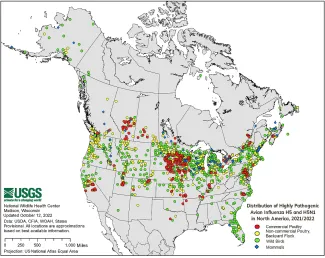
An outbreak of highly pathogenic avian influenza (HPAI) is underway in wild birds across the nation, including Oklahoma, which could pose a serious threat to domestic poultry production.
HPAI has been confirmed in hunter-harvested birds this fall in Oklahoma. It is likely that migratory birds will be carrying the virus this fall and winter, and that the public will see some bird carcasses in the outdoors. Shorebirds, waterfowl, and raptors are the primary wild birds that will be affected.
Hunters and other outdoor recreationalists should be aware of the potential damage the HPAI virus can cause to the nation’s food supply and how they can lessen the chance of spreading the virus. The Oklahoma Department of Wildlife Conservation is urging outdoor recreationalists to take precautions to help protect domestic and industrial poultry flocks.
HPAI is particularly deadly to poultry. Infected wild birds may show no signs of being sick. Or they may show signs of infection including abnormal behavior such as not flying when startled, and hunters should watch for this type of behavior. In some cases, the virus will be fatal to wild birds.
Hunters should be aware that the HPAI virus remains a transmission threat in bird carcasses and in the environment. HPAI can also be transmitted via hunting equipment and clothing, including boots and gloves, and such items should not be allowed near any domestic birds. Vehicle tires can also transfer the virus, and anyone who has driven in an area where HPAI is suspected should consider spraying their vehicle’s tires and undercarriage.
The public need not report small numbers of dead wild birds. But state officials do want to receive reports of dead or sick birds if 12 or more are seen in one area, as especially if a group of dead birds in within six miles of any poultry production facility. Those reports can be called in to the Oklahoma office of the USDA’s Animal and Plant Health Inspection Service (APHIS) at (405) 521-4039. Reports of dead or sick domestic poultry can be reported to the Animal Industry State Veterinarian at (405) 522-6141.
Anyone who finds sick or dead birds should minimize contact with them. Do not touch them with bare hands. When disposing of dead birds suspected to be diseased, wear impermeable gloves or use doubled plastic bags to collect the carcass, tie the bag closed, and put it in the garbage can. Discard any gloves in the garbage, and wash hands with soap and water after handling.
While it is possible for HPAI to be transmitted to people, it’s not likely, officials said.
According to the U.S. Centers for Disease Control and Prevention, this strain of HPAI does not present an immediate public human health concern. However, waterfowl are considered more susceptible to HPAI than other game birds. So, the U.S. Fish and Wildlife Service recommends the following to hunters when handling wild game to prevent possible transmission of HPAI or other potential pathogens and lessen the risk of further spreading the virus in the environment:
- Do not handle or eat sick game.
- Field dress and prepare game outdoors or in a well-ventilated area.
- Wear rubber or disposable latex gloves while handling and cleaning game.
- When finished handling game, wash hands thoroughly with soap or disinfectant.
- Clean knives, equipment, and surfaces that come into contact with game.
- Do not eat, drink, or smoke while handling wild or domestic animals.
In addition to the above list of precautions, it is suggested that hunter-harvested birds that did not appear to be sick should be cooked to an internal temperature of 165 degrees to kill any virus present before consuming the meat.
“Bird flu” viruses do not normally infect people. However, sporadic human infections with bird flu viruses have occurred. The current HPAI virus in the U.S. is genetically different from previous outbreaks in other areas of the world that have infected people and caused severe illness with high mortality, according to the CDC.
Hunters seeking more information can go to https://www.aphis.usda.gov/publications/animal_health/fsc_hpai_hunters.pdf.
For more information on the nationwide distribution of this HPAI virus, go to https://www.usgs.gov/media/images/distribution-highly-pathogenic-avian-influenza-h5-and-h5n1-north-america-20212022.
